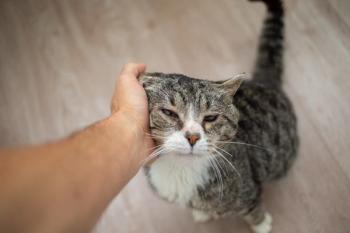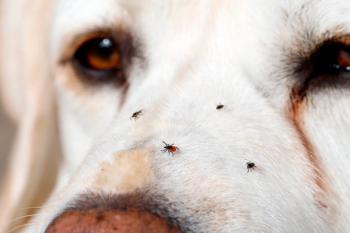
- dvm360 May 2024
- Volume 55
- Issue 5
- Pages: 27
Canker makes us all cranky
Early treatment and a multimodal approach can help improve patient outcomes
Canker, or proliferative pododermatitis, is a disease process resulting in chronic hypertrophic proliferation of hoof tissues. Canker typically starts with the frog but can expand to involve the bars, sole, and hoof wall in more severe cases. Wet conditions are thought to predispose to the development of canker; but, it can be seen in horses with access to clean, dry conditions as well. An infectious process has long been hypothesized as a primary or contributing factor in canker development; however, a causal connection between pathogens and disease has yet to be identified. Some examined infectious causes include Treponema bacteria or bovine papillomavirus.1-3
Symptoms
Draft horses are overrepresented; however, canker can occur in any breed in 1 or multiple hooves. Often the first symptom of canker is difficulty for the farrier picking the hooves, likely due to the horse’s discomfort when canker tissue is manipulated. The frogs on these horses may bleed when getting cleaned, and there may be areas that appear wet or exudative, which can lead to a misdiagnosis of thrush. However, thrush is a destructive process, while canker results ultimately in tissue proliferation, which may not be apparent early in the disease process. As canker progresses, you may see small areas of red or white tissue with a soft texture, unlike the surrounding keratinized frog. Continued growth may show finger-like tissue projections, classically described as a cauliflower-like (Figure 1).4 Canker tissue may be accompanied by a foul odor and caseous white exudate.4 Lameness may or may not be present depending on the extent of affected tissue and whether it contacts the ground, but more often, horses will resent palpation or manipulation of the tissue, often quite significantly or violently.
Diagnosis
Diagnosis of canker is typically made based on clinical signs but histology can be used to confirm the diagnosis. Histologically, this tissue appears as chronic hypertrophic pododermatitis. Culture often reveals a mix of environmental bacteria and does not yield additional insight.4
Treatment and prognosis
Multiple modalities of treatment have been described and used with varying success. Resolution typically requires a multimodal approach, and it has been the author’s experience that the need for several therapeutic sessions should be anticipated and conveyed to the owner prior to starting therapy. Sharp debridement appears to be key in most cases for successful treatment. This can be performed under general anesthesia or with local anesthesia as a standing procedure. An Esmarch tourniquet will improve visualization of affected tissue. Sharp debridement should be continued down to healthy frog corium, which can be recognized by a change in color and texture; canker tissue is soft and spongy to the touch, while healthy corium will have a firmer texture (Figure 2). Although it is inadvisable to debride excessively, more often inadequate debridement occurs, and any remaining abnormal tissue will proliferate again rapidly. The author typically applies a heavy pressure bandage following debridement as the tissue will continue to bleed, and follows up with additional therapy beginning 24 hours after sharp debridement.
Cryotherapy can be a useful adjunctive therapy in the management of canker and is often recommended following initial sharp debridement. A series of 2 to 3 freeze-thaw cycles over the entire affected area should be performed. Topical therapy is another commonly used adjunctive therapy. The most used topical is 10% benzoyl peroxide in combination with metronidazole. This topical therapy helps to dry out the tissue surface and reduce the microbial burden of healing tissues. Hoof bandages and topical therapy should be changed daily to every other day.
The author prefers to maintain patients in hoof bandages for the first week or so until additional sharp debridement is unlikely, as it can be difficult to work around a shoe. However, a hospital plate shoe should be applied for continued therapy as the hoof can be kept cleaner and drier than what can be maintained with a hoof bandage. This disease necessitates a good working relationship with the patient’s farrier, who will be providing care through a hospital plate and can be key in monitoring for evidence of canker regrowth.
Oral prednisolone has been described in literature as an adjunctive therapy. The author has found it helpful in reducing the duration of initial therapy and the risk for recurrence in horses without contraindication for systemic steroid use. Current recommendations for prednisolone therapy involve an initial dose of 1 mg/kg once daily, followed by a tapering course over 3 to 4 weeks.4
The prognosis for canker is considered guarded but is more favorable with aggressive therapy. The author prefers to keep patients hospitalized for the first 2 to 3 weeks as repeated sharp debridement and/or cryotherapy is commonly needed, which can be performed immediately if new canker growth is noted while in the hospital with daily bandage changes. The owner should be made aware prior to starting therapy of the high likelihood of a long therapeutic course and the potential for recurrence in the future.
Clinical takeaways
Early and aggressive treatment of canker, prior to extensive abnormal tissue growth, improves both the short- and longterm prognosis; however, prognosis remains guarded. Horses with a recent change in allowing their hooves to be handled should be closely examined for abnormal tissue growth, as early canker may be difficult to recognize.
A multimodal treatment approach, ideally in a hospital setting where close monitoring and additional therapy are possible, appears to provide the most successful outcome. Owners should be made aware up front of the time commitment along with the guarded prognosis even with appropriate therapy, and close continued communication among owner, farrier, and veterinarian are key to ultimate success.
REFERENCES
- Marcekova P, Mad’ar M, Stykova E, et al. The presence of Treponema spp. in equine hoof canker biopsies and skin samples from bovine digital dermatitis lesions. Microorganisms. 2021;9(11):2190-2200. doi:10.3390/microorganisms9112190
- Sykora S, Brandt S. Occurrence of Treponema DNA in equine hoof canker and normal hoof tissue. Equine Vet J. 2015;47(5):627-630. doi:10.1111/evj.12327
- Brandt S, Schoster A, Tober R, et al. Consistent detection of bovine papillomavirus in lesions, intact skin and peripheral blood mononuclear cells of horses affected by hoof canker. Equine Vet J. 2011;43(2):202-209. doi:10.1111.j.2042-3306.2010.00147.x
- Redding WR, O’Grady SE. Nonseptic diseases associated with the hoof complex: keratoma, white line disease, canker, and neoplasia. Vet Clin North Am Equine Pract. 2012;28(2):407-421. doi:10.1016/j.cveq.2012.06.006
Articles in this issue
over 1 year ago
PROfile: Fifteen years’ worth of dilemmasover 1 year ago
Calming the stressed catover 1 year ago
Be the Beyoncé and innovate awayover 1 year ago
Fearless collaboration in the clinicover 1 year ago
5 tips for rewarding job searchesover 1 year ago
Balancing care with capitalover 1 year ago
The coerenza approach: A guide to comprehensive pet careover 1 year ago
Ticks: Necessity or nuisance?over 1 year ago
Booking weeks outNewsletter
From exam room tips to practice management insights, get trusted veterinary news delivered straight to your inbox—subscribe to dvm360.






